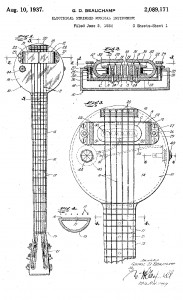Think of a rock and roll band and what musical instrument comes to mind? For most it’s the electric guitar, and it’s big cousin the electric bass. It just isn’t rock and roll without the driving beat. Rock wouldn’t be what it is without these electric guitar inventors.
Earliest History

Guitars had been with us for a long time. Its predecessors have been dated back to the 9th century or before. But acoustic guitars didn’t put out enough volume to work well in a band until these electric guitar inventors came along. Early efforts to mount a microphone in the guitar didn’t work well. Mikes of the time didn’t handle a full range of tones and picked up a lot of background noise, scraping sounds, and worst of all, feedback.
George Beauchamp was a guitarist in the 1920s who experimented with amplification for his Hawaiian guitar. In 1931, Beauchamp partnered with Adolph Rickenbacker, an electric engineer, to invent what is considered to be the first electromagnetic pickup that produced clear sound. Their invention was first mounted in a Hawaiin lap guitar. The induction pickup directly sensed the vibration of the strings and wasn’t affected by ambient sounds or feedback. The guitar was known as the “frying pan” for its shape and aluminum body. Rickenbacker’s company manufactured them, and the electric guitar was born.
Hawaiin music was big in the 20s and 30s, and the guitar caught on quickly. Musicians in other types of bands soon took a liking to it, and the need for more traditional electric guitars followed. Rickenbacker was the first of our big hero electric guitar inventors.
Electric Guitar Inventors: Les Paul
Les Paul was the next big electric guitar inventor hero. His style was a mix of jazz, blues and country and the Hawaiin lap guitar didn’t quite fit in. Les Pauls tinkering with electric guitar design led to a model he called “the log”. Initially, it was little more than a 4-foot piece of lumber with hardware attached. He later added the body of a sawn away Epiphone guitar for looks.

Electric Guitar Inventors: Leo Fender
A few years later, Clarence Leonidas Fender, better known as Leo Fender, improved on the basic design with a solid body. His Fender Telecaster became the first successful mass-produced solid body electric in 1950, followed by the Fender Stratocaster in 1954, just in time for the birth of rock and roll. The Stratocaster featured three separate pickups and a string bending tremolo bar.
Along the way, Fender also introduced the Fender Precision Bass and Fender Bassman Amplifiers that replaced the stand-up bass used by most groups with what we recognize today as the Bass Guitar.
Early rock bands had a piano or sax at as the lead instrument, a stand up double bass, and a drum set. The guitar guys changed everything but the drums in most modern rock bands. Leo Fender and Les Paul are in the Rock and Roll Hall of Fame.